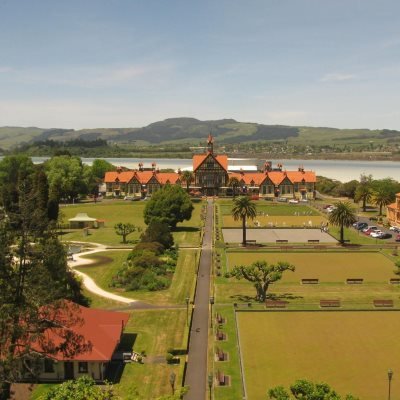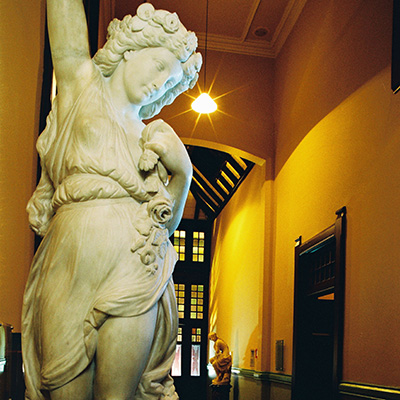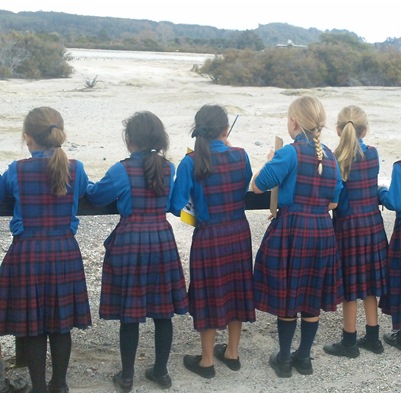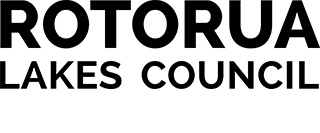Museum offering thriving one year on
Saturday, 18 November 2017
Rotorua’s history and stories are alive and well beyond the walls of Rotorua Museum a year after its unexpected closure.
This weekend marks a year since the museum was closed for public safety reasons when damage was discovered following the Kaikoura earthquake. Detailed design and costings for a preferred option for the historic museum building is now underway.
During the past year Rotorua Museum staff have hosted more than 34,000 people at a range of events, exhibitions, free tours and educational programmes held in alternative venues.
“I think what we’ve been able to do during the past year is demonstrate that a museum offering isn’t all about a building,” says Council’s Arts and Culture Director Stewart Brown. “While it has obviously been a challenging year, we’ve come up with other ways to share Rotorua’s history and rich stories and engage with as wide an audience as possible, maintaining our community presence.
“We’ve been able to achieve that by taking our offering “beyond the walls” of the museum, providing free historical tours of the Government Gardens, finding other places to host our educational programmes for schools and hosting exhibitions in other venues,” Mr Brown says.
Rotorua Mayor Steve Chadwick says resilience and innovation have ensured the success of events and programme run by the museum team this past year, despite the challenges.
“We all love our museum and it’s sad to see her closed but because of the complexity of this historic building, we need to take the time to do everything properly. We need to take a long-term view and we need to remain patient to allow the experts to do the work that will support our decisions,” the mayor says.
“I remain very confident all the right steps are being taken so that we can make the right decision for our community.
“Our wonderful museum team, including our passionate volunteers, haven’t let this stop them and they are to be congratulated for how they’ve innovated to find solutions. They’ve taken the museum outside the walls, sharing our important Rotorua stories and history through the Government Gardens tours, and they’ve continued on with educational programmes for schools and other projects.”
So what has the museum team been up to?
Here’s a breakdown of attendance at museum-run events (including Matariki talks, Easter Egg hunt, school holiday programmes, crafts and workshops), exhibitions, free tours and programmes during the past year:
Event attendance 7,512 people
Exhibition attendance 16,262 people
Educational attendance 7,571 people
Free Tours attendance 3,000 people
34,345 people
The Da Vinci Machines & Robots exhibition which was on display at the Sir Howard Morrison Performing Arts Centre – opening in December 2016 – was a touring display viewed by nearly 14,000 during its three months in Rotorua.
More recently the performing arts centre hosted the month-long exhibition of 48 finalist works submitted for the Rotorua Museum Art Awards 2017. Other entries were exhibited at the library.
“Many people are still visiting the Government Gardens and photographing the museum and the museum team has worked hard to ensure we continue to tell the stories of Rotorua and engage with both locals and visitors, moving ‘beyond the walls’ to achieve this,” Mr Brown says.
“Our volunteers have been fantastic, taking free daily tours through the Government Gardens which more than 3000 people have enjoyed to date.”
These continue, weather dependent, starting outside the museum at 11am and 2pm daily.
In June our passionate volunteer museum guides received some well-deserved recognition when they were awarded the Trustpower Rotorua Lakes Community Award for the Heritage and Environment category for their Outside the Walls Tours.
Museum staff continue to provide educational programmes with more than 7570 students from around the country attended during the past year. More than 60% were locals.
“We are looking for ways to generate some revenue and one of the museum’s most popular previous exhibitions, AEIOU, has been prepared as a touring exhibition. Revenue from that will contribute to future exhibitions,” Mr Brown says.
The team is working on some exciting plans for 2018, including exhibitions based in the Rotorua Lakes Council Galleria and in partnership with The Arts Village.
Mr Brown says the past year has also seen Museum staff strengthen existing partnerships and form new relationships by providing expert knowledge and skills for a range of projects including restoration of the Te Arawa War Memorial in Government Gardens, Te Puia projects, mentoring programmes for university art students and providing lighting expertise for the refurbished Buried Village exhibition.
What’s happened to the exhibition items that were in the museum?
Many permanent exhibition items have remained in the Rotorua Museum building in the south wing, which is above the earthquake safety threshold.
About 100 items are now in storage, having been removed from other parts of the building. This includes items from the permanent Taking the Cure exhibition (which was based in the north wing) and the 10 marble Summers sculptures which had been in the museum for more than 100 years.
What’s the current status of the museum and when will a decision be made?
There has been no change in the status of the museum building since the detailed seismic assessment which found it fell well below earthquake safety standards with most of the building at 15% of the National Building Standard (33% or below is earthquake prone), meaning it would require substantial work before it could be open to the public again.
Detailed design and costing for the preferred option for the museum is progressing and once complete, will be presented to elected members. This detailed work is expected to take another few months.
The situation with the museum is very different to the Sir Howard Morrison Performing Arts Centre which has been considered for an upgrade – along with seismic strengthening – for some years now. Consultation with the arts community regarding this dates back to 2014.
Both buildings were identified several years ago as being an earthquake risk – along with the iSite and Community House – and Council then had a timeframe by which to undertake detailed seismic assessments and strengthening work.
Initial assessments determine if a building is an earthquake risk and detailed assessments are the next step, used to determine if a building is earthquake prone and therefore requires more extensive strengthening work.
With regards to the museum several options were explored with engineers and the preferred option includes replacing the roof with a more lightweight option, inserting bracing into walls, installation of a new sub-floor and other strengthening work.
See THIS LINK for more about the status of the museum, the damage to the museum, quick facts and FAQs (from July 2017).
See THIS LINK for more information about the preferred option (from October 2017 update) and see THIS LINK to view the presentation made at that time which includes a detailed look at the options that were considered.
What is the financial impact of the museum closure?
It’s not possible to say exactly how much revenue has been lost as a result of the museum closure but revenue had averaged about $2.1m annually since 2014, from entry fees, retail sales and the museum café.
This year’s Lions Tour and the Lions Tour match in Rotorua had been expected to provide an additional boost.
The team is looking for ways to generate some revenue and one of the museum’s most popular previous exhibitions, AEIOU, has been prepared as a touring exhibition. Revenue from that will contribute to future exhibitions.











